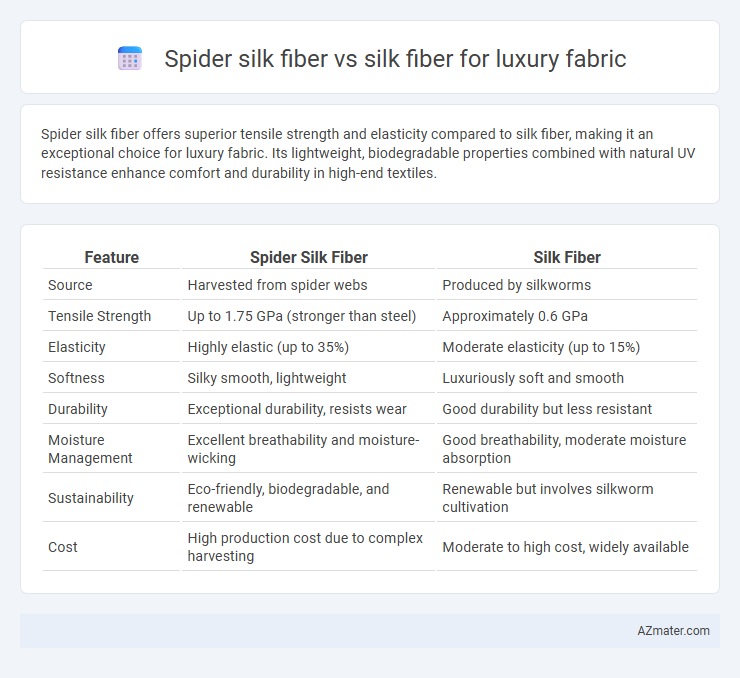Spider silk fiber offers superior tensile strength and elasticity compared to silk fiber, making it an exceptional choice for luxury fabric. Its lightweight, biodegradable properties combined with natural UV resistance enhance comfort and durability in high-end textiles.
Table of Comparison
| Feature | Spider Silk Fiber | Silk Fiber |
|---|---|---|
| Source | Harvested from spider webs | Produced by silkworms |
| Tensile Strength | Up to 1.75 GPa (stronger than steel) | Approximately 0.6 GPa |
| Elasticity | Highly elastic (up to 35%) | Moderate elasticity (up to 15%) |
| Softness | Silky smooth, lightweight | Luxuriously soft and smooth |
| Durability | Exceptional durability, resists wear | Good durability but less resistant |
| Moisture Management | Excellent breathability and moisture-wicking | Good breathability, moderate moisture absorption |
| Sustainability | Eco-friendly, biodegradable, and renewable | Renewable but involves silkworm cultivation |
| Cost | High production cost due to complex harvesting | Moderate to high cost, widely available |
Introduction to Spider Silk and Traditional Silk Fibers
Spider silk fiber exhibits exceptional tensile strength, elasticity, and lightweight properties, making it a cutting-edge material in luxury textiles. Traditional silk fibers, produced by silkworms, are prized for their natural sheen, smooth texture, and breathability, underpinning luxury fabric industries for centuries. Recent advancements in biotech have enabled scalable production of synthetic spider silk, offering a sustainable, high-performance alternative to conventional silk in premium fabric applications.
Origins: Spiders vs Silkworms in Silk Production
Spider silk fiber originates from orb-weaving spiders, producing a protein-based material renowned for its exceptional strength and elasticity, while traditional silk fiber is harvested from domesticated silkworms, primarily Bombyx mori. Spider silk production is challenging due to the territorial and cannibalistic nature of spiders, limiting large-scale harvesting, whereas silkworm farming benefits from well-established sericulture techniques allowing mass silk cultivation. The natural properties and renewable origins of both fibers influence their unique applications in luxury fabrics, with spider silk offering superior tensile strength and biodegradability compared to conventional silk.
Molecular Structure: Composition Differences
Spider silk fiber consists primarily of spidroin proteins with repetitive amino acid sequences rich in glycine and alanine, enabling exceptional tensile strength and elasticity. In contrast, silk fiber from silkworms is mainly composed of fibroin, a protein with a crystalline b-sheet structure formed by alternating glycine, alanine, and serine residues, providing softness and sheen. These molecular composition differences result in spider silk's superior mechanical properties, while silkworm silk emphasizes luster and smooth texture in luxury fabrics.
Mechanical Properties: Strength and Elasticity
Spider silk fiber exhibits remarkable mechanical properties, with tensile strength up to 1.75 GPa and elasticity reaching 35%, outperforming traditional silk fiber, which typically has a tensile strength around 0.5 GPa and elasticity near 15%. The unique molecular structure of spider silk provides exceptional toughness, combining high strength with flexibility, making it ideal for luxury fabrics requiring durability and comfort. In contrast, silk fiber, while valued for its softness and sheen, lacks the superior mechanical resilience needed for high-performance luxury textile applications.
Texture and Appearance: Visual and Sensory Appeal
Spider silk fiber offers a unique combination of ultra-fine texture and exceptional tensile strength, resulting in a luxurious fabric that feels exceptionally smooth and lightweight compared to traditional silk fiber. Silk fiber, derived from silkworms, boasts a natural sheen and soft, slightly elastic texture that provides a classic, elegant drape with a rich, lustrous appearance. Visually, spider silk exhibits a subtle iridescence and higher translucency, enhancing its allure, while the sensory appeal of both fibers emphasizes softness, but spider silk's superior resilience adds a distinct tactile durability favored in high-end luxury fabrics.
Environmental Impact of Silk Production
Spider silk fiber exhibits a significantly lower environmental impact compared to traditional silk fiber, as its production requires no mulberry cultivation or silkworm harvesting, thus reducing land use and pesticide application. Unlike conventional silk production, which involves boiling silkworms and generates considerable water pollution, spider silk can be synthesized biologically through bioreactors with minimal waste. This sustainable method results in a luxury fabric that supports eco-friendly fashion by minimizing biodiversity loss and lowering carbon emissions associated with conventional sericulture.
Cost Factors in Manufacturing
Spider silk fiber offers superior strength and elasticity compared to traditional silk fiber but incurs significantly higher manufacturing costs due to complex harvesting and synthetic production methods. Silk fiber, predominantly harvested from silkworm cocoons, benefits from established, large-scale sericulture processes that reduce costs and improve availability. The high expense of spider silk production limits its widespread use to exclusive luxury markets where its unique properties justify premium pricing.
Market Availability and Scalability
Spider silk fiber demonstrates superior tensile strength and elasticity compared to traditional silk fiber, but its market availability remains limited due to the complexities of bioengineering and production scale. Silk fiber from silkworms benefits from a well-established global supply chain, offering consistent quality and scalability for luxury fabric manufacturers. High production costs and technological hurdles currently restrict spider silk's widespread adoption, though ongoing advancements aim to enhance its market presence and commercial viability in the luxury textile sector.
Applications in Luxury Fabric Design
Spider silk fiber offers exceptional tensile strength, elasticity, and lightweight properties, making it ideal for innovative luxury fabric design that demands durability and comfort. Its natural biodegradability and hypoallergenic qualities appeal to eco-conscious fashion brands creating high-end garments and accessories. In contrast, traditional silk fiber remains prized for its smooth texture and sheen, favored in classic luxury apparel but often combined with spider silk to enhance performance and sustainability in avant-garde collections.
Future Trends: Innovations in Silk Technologies
Spider silk fiber exhibits remarkable tensile strength and elasticity compared to traditional silk fiber, positioning it as a revolutionary material in luxury fabric innovation. Advances in biotechnology have enabled scalable production of synthetic spider silk, facilitating sustainable and eco-friendly alternatives that enhance fabric performance and durability. Future trends emphasize integrating nanotechnology and genetic engineering to tailor fiber properties, driving the next generation of high-performance luxury textiles.

Infographic: Spider silk fiber vs Silk fiber for Luxury fabric
 azmater.com
azmater.com